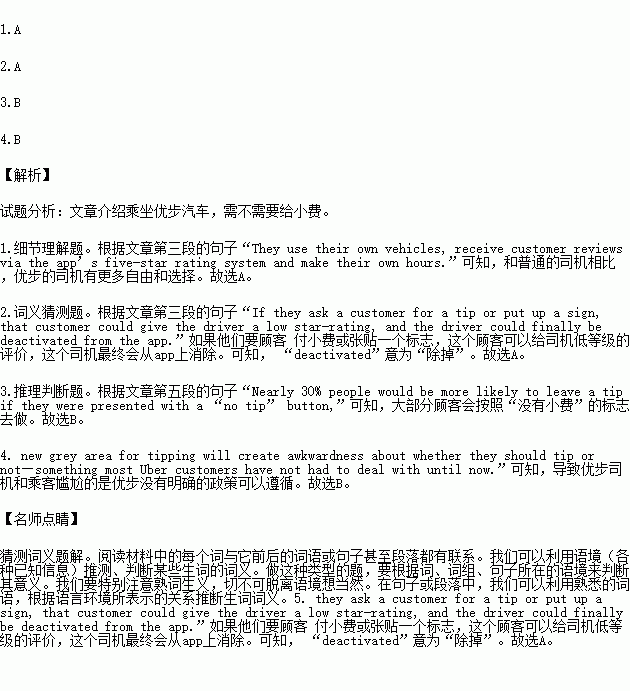题目内容
When Taking an Uber-Should You Tip or Not?
Taking an Uber car may no longer be a direct driver-passenger and guilt-free experience. The ride-sharing experience is about to get awkward.
With the wide application of the Internet, Uber, a new approach to your destination instead of taking an ordinary taxi, has become more popular recently. However, benefits won’t come without its fair share of drawbacks.
Uber drivers are a part of the so-called sharing economy: They use their own vehicles, receive customer reviews via the app’s five-star rating system and make their own hours. Unlike other services, Uber claimed that drivers all over the country could clearly alert customers that tipping is not included. Those drivers that expect to be tipped can make their wishes known. But the company is holding to its official no-tip-required line, according to its website. “Once you arrive at your destination, your fare is automatically charged to your credit card on file—There’s no need to tip.” Although drivers value their independence—the freedom to push a button rather than punch a clock, lack of a clear policy, however, leaves Uber drivers in a vulnerable(脆弱的) position: If they ask a customer for a tip or put up a sign, that customer could give the driver a low star-rating, and the driver could finally be deactivated from the app.
But has the company done a good job working with customers? Some observers say that this new grey area for tipping will create awkwardness about whether they should tip or not—something most Uber customers have not had to deal with until now. Uber did not respond to customers’ comment, just leaving their rating in the air(ignoring it).
Providing an option to tip on an app sends a clear message to customers to reach into their pockets. Nearly 30% people would be more likely to leave a tip if they were presented with a “no tip” button, according to Guinn’s 2015 survey of roughly 500 people. When people are presented with three tip choices—20%, 25% or 30%—they’re more likely to choose the middle option even if it’s more than the traditional 20%, according to a separate 2014 analysis of 13 million New York City taxi rides.
If the service is twice as expensive during a rain storm or public transport delay, the customer has the right not to tip. However, if the driver is extra helpful or avoids traffic to reach your destination in a more timely manner, you could give an extra tip, says Uber, who will leave tipping options in the hands of the consumer rather than the app.
1. Compared with taxi drivers, Uber drivers ______.
A. enjoy more freedom and choices
B. support the company’s practice
C. clock up the miles while driving
D. receive customers reviews directly
2.The underlined word “deactivated” in Paragraph 4 probably means ______.
A. removed B. degraded C. tracked D. charged
3.From the survey we can conclude most customers ______.
A. would probably tip if there is an option
B. usually do as the “no tip” sign suggests
C. tip because of Uber drivers’ good service
D. are disappointed to reach into their pockets
4.What causes the awkwardness between Uber drivers and their customers?
A. Customers take advantage of the new grey area for tipping.
B. There is no specific policy from the Uber to follow.
C. It’s up to customers to decide the drivers’ earnings.
D. Customers tend to pay least among the 3 choices.

